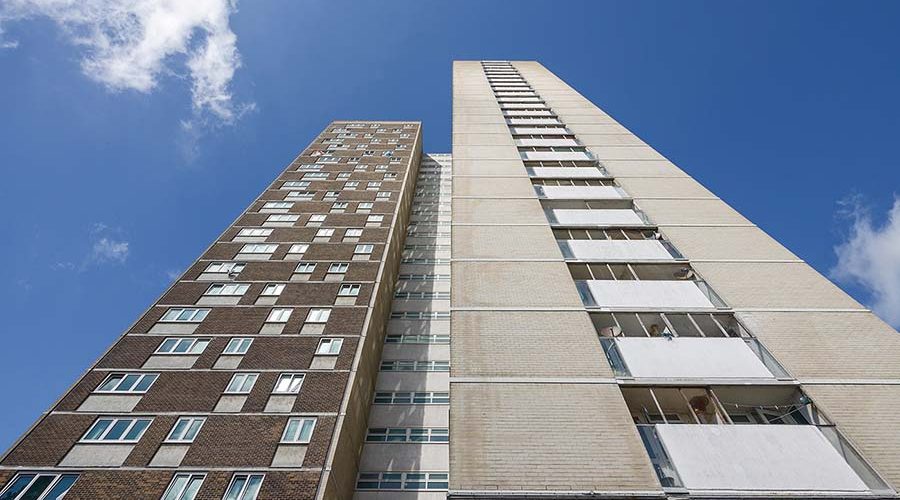Ed Swift, National Sales Manager – Public Sector for Polypipe Building Services, talks about solutions for drainage stack replacement in public sector buildings.
Polypipe
The Government ‘lockdown’ and rules around social distancing in 2020 have impacted on many areas of industry – not least those involved in repairs and refurbishments to public sector housing.
Many drainage systems in tower blocks need replacing, but this often requires moving residents from their homes. A lot of these systems are the original cast-iron drainage systems which were installed in buildings that are 40 to 50 years old.
Issues arising from these ageing systems may include underground leaks, corroded pipes and internal blockages. A failing drainage stack can also lead to sanitation issues that affect the health and wellbeing of residents.
The advantages of using a live stack replacement service, such as the Terrain service offered by Polypipe Building Services, start from the first survey with ultra-sonic testing which will give building-owners an accurate prediction on the estimated working life remaining in the existing drainage stack.
As part of the service, installers are trained by specialists from the manufacturer before they use the products which, along with the key stage inspections carried out by Polypipe’s building services technical team, will mean a smoother and more efficient installation.
The combination of planning and offsite manufacturing allows drainage systems to be replaced in sections. This ensures a fast, efficient replacement process – during which residents can remain in their homes.
An existing drainage system can then be replaced section by section, floor by floor, without having to disturb the majority of residents in a building at any one time.
Live stack replacement is a method that allows public sector organisations and their sub-contractors to work with manufacturers at the outset of a project.
The service enables building owners and contractors to build a viable timeline plan, and to consider and anticipate other remedial works that could be conducted during
the same works period in order to minimise disruption to the residents.
Millbrook Tower and Carr House
The replacement service has been used on nearly 300 high-rise buildings including the Millbrook Tower in Southampton and Carr House near Wakefield.
Millbrook Tower is more than 50 years old and owned by Southampton City Council (SCC). The building had a cast-iron drainage system that had started to rust and fail, causing excessive leaking in the 144 flats.
SCC chose to work with a manufacturer specialising in offsite production of building components. The team from the council was able to complete the installation work across all of its 144 flats.
SCC underwent a training programme, giving its direct labour organisation the technical skills required to better understand the specification, assembly and installation of plastic drainage stacks.
This in-house technical ability enabled the council to start a programme within the city addressing drainage issues that were having an impact on residents and structural elements of the buildings.
Working with manufacturing experts, SCC assessed the failing drainage stacks in Millbrook Tower. A long-term solution was required, which would eliminate emergency callouts and recurring reactive repairs in this and other residential blocks within the city. A high-density polyethylene system was selected for offering a number of key benefits over other more traditional materials.
As much of the assembly of the replacement drainage system was carried out in factory conditions and then delivered to site, the residents of Millbrook Tower were able to remain in their properties, as the installation process could be completed much quicker than when assembling loose products onsite.
Jim Simpkins, Housing Refurbishment Project Manager for SCC, said: “Millbrook Tower has been standing for 50 years and the drainage systems in place were not functioning as well as required. Polypipe Building Services gave our team expert advice with the specification, manufacture and installation of replacement drainage stacks.”
With the Carr House project, Polypipe Building Services was approached by housing association Wakefield and District Homes (WDH) to manufacture a solution to replace the 11-storey building’s “aged and blocked” cast-iron internal soil stacks.
WDH agreed to Polypipe Building Service’s live stack replacement solution to use 22 stacks of Terrain FUZE, manufactured offsite, as it would be easy to install and allowed the tenants of Carr House to remain in their homes during the retrofit work.
Polypipe Building Services worked with Barnsley-based contractor Hughie Construction to ensure there was minimal disruption for residents during the install. Despite the challenges of replacing the stack in a high-rise property, the installation took 10 days to complete.
Fire protection
Conducting drainage stack replacement work also provides an opportunity to improve the fire protection provisions deployed upon drainage systems, with a number of firetrap and fire sleeve solutions available.
Many existing stacks will need new fire-trapping installations, so it makes sense to also fully replace old stacks when rectifying the fire protection provisions.
The Terrain firetrap sleeves, for example, provide up to four hours of fire compartmentation for drainage soil stacks, while the collars provide up to two hours so that Building Regulations are not just met, but exceeded.
When installing plastic pipes in any high-rise building, it is important to protect them from the effects of fire. The passive fire protection products specified for use with drainage stack systems need to comply with BS 476 Part 20 and BS EN 1366-3.
Authorities are now looking for more elegant holistic solutions that allow for more refurbishment issues to be addressed as part of a wider assessment of the safe operation of the building.
With up to 4500 tower blocks to maintain, early diagnosis of drainage concerns combined with live stack replacement is the optimal solution for public sector asset teams to keep residents at home while completing vital work.







